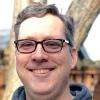Here through an Amazing Sequence of Events
I am so thrilled that I was selected to participate in the 2020-2021 field season of the PolarTrec program. What might be a diversion of life’s course for some, feels like a connect-the-dots to me.
After graduating from Beloit College with a degree in Environmental Biology, I spent several years as an environmental educator. The best thing about environmental education was that your subject matter was all around you. Teaching about wetlands? You are in a wetland. Learning about decomposers? Open a rotten log. I brought this love of experiential education with me when I began graduate school at Southern Illinois University Edwardsville. While studying in the department of Curriculum and Instruction, I accidentally became involved in a research grant investigating collembola. My professor wanted to look at species composition in flood disturbed sites. I wanted to propagate the most popular craze of the decade- pocket pets - springtails in small pocket sized containers. The modern successor to the Sea Monkey.
 A tardigrade from the Dry Valleys Ecosystem project. Known in Missouri as the moss piglet
A tardigrade from the Dry Valleys Ecosystem project. Known in Missouri as the moss piglet
As things happen, I got my teaching certification (I don’t remember what I decided about pocket pets) and taught for several years in a very traditional seats-in-a-row, book-based district. As an experiential learner, I knew why my students were not connecting with science. We had a lot of neat programs and opportunities for our students but I wanted to be able to incorporate authentic experiences.
I am now at a small, progressive suburban public school district in the town of Maplewood, Missouri, on the border of Saint Louis City. In our school we teach science, and all subjects for that matter, through the lens of “school as expedition”. We connect all of our content to real world expeditions and experiences. This philosophy enables us to close the experience gap that hinders the success of many students in diverse communities throughout the US. When learning about energy we study our own honeybees, when exploring the carbon cycle we climb and measure a giant oak, and when investigating the water cycle we canoe along several orders of streams. By providing all students with solid experiential learning opportunities our school has become a model green school.
 Sometimes it's best to start a fire.
Sometimes it's best to start a fire.
A few years ago we decided we were really not doing enough to educate about climate change and the science and geography of our polar regions. We are on the largest river in North America and at the border of the Ozarks, Eastern forest and tallgrass prairie. Most of our learning is about the temperate world. To address this, my colleague, Allison Hoffman, and I decided to participate in the Polar Interdisciplinary Coordinated Education PolarSCI project.
Our students spent 2 months learning about Antarctic research at the Palmer station on the Western Antarctic Peninsula. Students used real, raw data from the Long Term Ecological Research (LTER) area to compare variables and look for connections between weather, climate, photosynthesis, penguin populations, reproductive success, sea ice thickness and dozens of other variables. At the end of the project they presented their work at a symposium with professors and scientists from various polar research fields.
The students produced amazing, high quality work. They also complained. A lot. They learned that doing real science takes brain power. They learned real science makes mistakes, miscalculations, and errors in technique. This is the kind of science teaching I want. All the time.
So, I love expeditionary learning where new understandings are based on real data and observations. I applied to be a part of the PolarTREC program because I learn through experience and I love being a part of science. I want to provide vicarious experiences for my students who can not visit the poles. I want to be the scientist that they know. I want them to connect stories they read about, data they study, and graphs they interpret with real scientists. Scientists that can be like them. I am going to be working with Dr. Byron Adams from Brigham Young University in the McMurdo Dry Valleys of Antarctica. This is one of the most extreme places for life on Earth. We are going to be investigating the tough little soil organisms that call this place their home. I am excited to bring the work of Dr. Adams and his team to a larger audience and connect the work of polar scientists to student understanding.
 View of the McMurdo Dry Valley ecosystem
View of the McMurdo Dry Valley ecosystem
I’ll post soon some background about the largest land animals of Antarctica next time. Here’s the dot - one of them is a collembola. Polar Pocket Pals? Leave me a question or comment about something you have always wondered about Antarctica!


Comments
Add new comment